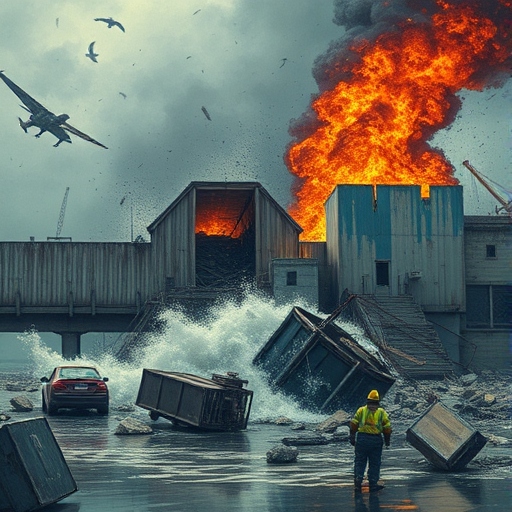Disasters can be broadly categorized into natural and manmade (or anthropogenic) types, based on their origin and cause. Both types can have devastating effects on human life, infrastructure, and ecosystems, but their sources, characteristics, and the measures taken to mitigate them often differ significantly.
Natural Disasters
Natural disasters are catastrophic events that occur as a result of natural processes of the Earth. These events are typically unpredictable and can cause significant damage to communities, ecosystems, and economies. They are often caused by geological, meteorological, hydrological, or biological factors. Some common types of natural disasters include:
- Earthquakes: These are sudden, violent shaking of the ground, caused by movements of tectonic plates or volcanic activity beneath the Earth’s surface. Earthquakes can lead to massive destruction of buildings, roads, and infrastructure, as well as causing landslides, tsunamis, and fires.
- Floods: Floods occur when water exceeds its normal levels and inundates areas that are typically dry. They can result from heavy rainfall, river overflow, dam failure, or even rapid snowmelt. Floods can lead to widespread destruction of property, crops, and infrastructure
. - Hurricanes, Typhoons, and Cyclones: These are powerful tropical storms with strong winds, heavy rainfall, and storm surges. They form over warm ocean waters and can cause widespread damage to coastal areas through flooding, high winds, and storm surges.
- Tornadoes: These are rapidly rotating columns of air that form over land, creating a funnel-shaped cloud. Tornadoes can cause significant localized damage due to their intense winds, tearing apart buildings and uprooting trees.
- Wildfires: These are uncontrolled fires that spread rapidly through vegetation, often in dry areas. Wildfires are common in regions with hot, dry climates and can destroy vast areas of forest and farmland, causing loss of life and habitat.
- Droughts: A drought is an extended period of deficient rainfall that leads to water shortages, crop failure, and economic hardship. Droughts can have devastating effects on agriculture, water supply, and food security.
- Volcanic Eruptions: These occur when magma from beneath the Earth’s crust erupts onto the surface, leading to the release of ash, gases, and lava. Volcanic eruptions can devastate surrounding areas, destroy infrastructure, and pose long-term environmental risks.
Manmade Disasters
Manmade disasters, also known as anthropogenic disasters, are events caused by human activities, typically resulting from negligence, poor management, or intentional actions. Unlike natural disasters, these are often preventable or mitigated with proper planning and regulations. Some examples of manmade disasters include:
- Industrial Accidents: These occur due to failures in industrial processes or the malfunction of machinery, often leading to chemical spills, fires, or explosions. Notable examples include chemical plant explosions, oil spills, and nuclear accidents. Such disasters can have severe environmental, health, and economic impacts.
- Nuclear Accidents: A nuclear disaster can occur when there is a failure in a nuclear power plant, leading to the release of radioactive materials. Notable incidents include the Chernobyl disaster (1986) and the Fukushima disaster (2011). These incidents have long-lasting environmental and health effects on affected populations.
- Oil Spills: Oil spills occur when petroleum products are accidentally released into the ocean or other bodies of water, often from tankers, drilling rigs, or pipelines. They cause extensive damage to marine life, disrupt fishing industries, and contaminate coastal environments.
- Chemical Spills and Toxic Waste: These disasters occur when hazardous chemicals are improperly stored or disposed of, leading to the release of toxic substances into the environment. This can cause severe health risks for local populations and ecosystems, such as the Bhopal gas tragedy in India (1984), one of the worst industrial disasters in history.
- Deforestation and Soil Erosion: While not an immediate disaster, the long-term effects of deforestation, land degradation, and soil erosion can lead to serious environmental consequences, including floods, landslides, and loss of biodiversity.
- Urban Disasters: These occur in densely populated urban areas due to poor infrastructure, inadequate urban planning, or corruption. Examples include building collapses, fires in slum areas, and water supply contamination.
- War and Terrorism: Conflicts, both international and domestic, can lead to large-scale manmade disasters. Terrorist attacks, such as bombings, and armed conflicts often result in loss of life, destruction of property, and long-term socio-economic damage.
Disaster Management System in India
India is prone to a variety of natural disasters, including floods, earthquakes, cyclones, and droughts, due to its geographical location and climate. Additionally, the rapid pace of urbanization, industrialization, and population growth in recent years has increased the risk of manmade disasters. To mitigate these risks and minimize the impact of disasters, India has established a disaster management framework that involves prevention, preparedness, response, and recovery.
Key Elements of India’s Disaster Management System
- National Disaster Management Authority (NDMA): The NDMA, headed by the Prime Minister, is the apex body responsible for the formulation of policies, plans, and guidelines for disaster management. The authority coordinates disaster response efforts at the national level, works with other agencies to improve disaster preparedness, and helps in capacity-building activities. It also conducts research on disaster risk reduction.
- State Disaster Management Authorities (SDMA): Each state in India has its own disaster management authority, which is responsible for implementing disaster management policies and plans at the state level. The SDMAs work in coordination with the NDMA to ensure that disaster response and preparedness are in place.
- Disaster Management Plans: India has developed various disaster management plans to address specific types of disasters. These plans provide detailed procedures and strategies for disaster response and recovery, as well as guidelines for evacuation, relief, and rehabilitation.
- Disaster Response Teams: India has established specialized disaster response teams to respond to disasters swiftly. These teams include the National Disaster Response Force (NDRF), which is a specialized force tasked with responding to natural and manmade disasters. The NDRF is well-trained and equipped to handle a wide range of emergencies, from flood relief to earthquake rescue operations.
- Early Warning Systems: The government of India has developed and implemented early warning systems for cyclones, earthquakes, and floods. These systems help in issuing timely alerts to vulnerable communities, allowing for better preparedness and evacuation. The Indian Meteorological Department (IMD) plays a key role in forecasting weather-related disasters.
- Training and Awareness Programs: Public awareness campaigns and training programs are an integral part of India’s disaster management strategy. These programs aim to educate citizens about disaster preparedness, first aid, and evacuation procedures. The NDMA and other agencies work to ensure that communities, especially in disaster-prone areas, are equipped with the knowledge to respond to emergencies.
- Financial Assistance and Relief: The central government provides financial assistance to affected states through the National Disaster Response Fund (NDRF) and the State Disaster Response Fund (SDRF). These funds are used for immediate relief activities, including food, water, shelter, and medical supplies.
- Rehabilitation and Reconstruction: After the immediate response phase, the focus shifts to rehabilitation and reconstruction. The government, in collaboration with NGOs and international agencies, provides long-term support to affected communities, helping them rebuild their lives and livelihoods.
- Technological Integration: The Indian government has integrated technology into disaster management, with the use of geographic information systems (GIS), satellite imagery, and drones for monitoring and assessing disaster situations. Technology has also been instrumental in improving the efficiency of early warning systems and response operations.
Effectiveness of the Disaster Management System in India
India’s disaster management system has made significant progress in recent years, but challenges remain. Some of the strengths of the system include:
- Improved Coordination: The establishment of the NDMA and SDMAs has led to better coordination between the central and state governments during disasters. This ensures a more efficient response and reduces delays in delivering relief.
- Enhanced Preparedness: Early warning systems and disaster preparedness drills have improved the ability of communities to respond to emergencies. The NDRF has been successful in carrying out rescue operations in the aftermath of disasters like floods, earthquakes, and cyclones.
- Community Participation: India has made efforts to involve communities in disaster management. Training programs, awareness campaigns, and local-level response teams have empowered people to take an active role in disaster preparedness and response.
However, there are several challenges to the effectiveness of the disaster management system:
- Overwhelming Scale of Disasters: Despite improvements, the scale of some disasters, especially those like major floods or earthquakes, can overwhelm the response system. In such cases, delays in relief distribution and the inability to reach remote areas remain significant challenges.
- Infrastructure Deficiencies: In many rural and disaster-prone areas, infrastructure such as roads, communication systems, and hospitals remain inadequate, making it difficult to carry out effective relief operations.
- Environmental Degradation: Environmental degradation, such as deforestation, uncontrolled urbanization, and climate change, has exacerbated the impact of natural disasters in India. These issues make it more difficult to predict and manage the effects of disasters.
- Coordination with International Agencies: Although India has a strong domestic disaster management system, coordination with international agencies during large-scale disasters could be improved, especially for technical assistance and long-term recovery.
Conclusion
Natural and manmade disasters pose significant challenges to India, but the country has developed a robust disaster management system over time. The focus on preparedness, response, and recovery, along with increased public awareness and technological integration, has helped mitigate the impact of many disasters. However, there is still much to be done in terms of infrastructure development, environmental protection, and effective coordination at all levels of governance to ensure better disaster resilience in the future.




